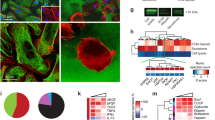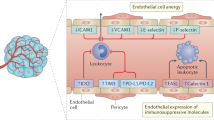Abstract
Tumor cells are elusive targets for immunotherapy due to their heterogeneity and genetic instability. Here we describe a novel, oral DNA vaccine that targets stable, proliferating endothelial cells in the tumor vasculature rather than tumor cells. Targeting occurs through upregulated vascular-endothelial growth factor receptor 2 (FLK-1) of proliferating endothelial cells in the tumor vasculature. This vaccine effectively protected mice from lethal challenges with melanoma, colon carcinoma and lung carcinoma cells and reduced growth of established metastases in a therapeutic setting. CTL-mediated killing of endothelial cells indicated breaking of peripheral immune tolerance against this self antigen, resulting in markedly reduced dissemination of spontaneous and experimental pulmonary metastases. Angiogenesis in the tumor vasculature was suppressed without impairment of fertility, neuromuscular performance or hematopoiesis, albeit with a slight delay in wound healing. Our strategy circumvents problems in targeting of genetically unstable tumor cells. This approach may provide a new strategy for the rational design of cancer therapies.
This is a preview of subscription content, access via your institution
Access options
Subscribe to this journal
Receive 12 print issues and online access
$209.00 per year
only $17.42 per issue
Buy this article
- Purchase on Springer Link
- Instant access to full article PDF
Prices may be subject to local taxes which are calculated during checkout





Similar content being viewed by others
References
Folkman, J. Addressing tumor blood vessels. Nature Biotechnol. 15, 510 (1997).
Folkman, J. Angiogenesis and angiogenesis inhibition: An overview. EXS 79, 1–8 (1997).
Folkman, J. Antiangiogenic gene therapy. Proc. Natl. Acad. Sci. USA 95, 9064–9066 (1998).
O'Reilly, M.S., Holmgren, L., Chen, C. & Folkman, J. Angiostatin induces and sustains dormancy of human primary tumors in mice. Nature Med. 2, 689–692 (1996).
O'Reilly, M.S. et al. Endostatin: An endogenous inhibitor of angiogenesis and tumor growth. Cell 88, 277–285 (1997).
Augustin, H.G. Antiangiogenic tumor therapy: Will it work? Trends Pharmacol. Sci. 19, 216–222 (1998).
Eberhard, A. et al. Heterogeneity of angiogenesis and blood vessel maturation in human tumors: implications for antiangiogenic tumor therapies. Cancer Res. 60, 1388–1393 (2000).
Folkman, J. Tumor angiogenesis and tissue factor. Nature Med. 2, 167–168 (1996).
Goede, V. et al. Prognostic value of angiogenesis in mammary tumors. Anticancer Res. 18, 2199–2202 (1998).
Folkman, J. Can mosaic tumor vessels facilitate molecular diagnosis of cancer? Proc. Natl. Acad. Sci. USA 98, 398–400 (2001).
Heidenreich, R., Kappel, A. & Breier, G. Tumor endothelium-specific transgene expression directed by vascular endothelial growth factor receptor-2 (FLK-1) promoter/enhancer sequences. Cancer Res. 60, 6142–6147 (2000).
Hicklin, D.J., Marincola, F.M. & Ferrone, S. HLA class I antigen downregulation in human cancers: T-cell immunotherapy revives an old story. Mol. Med. Today 5, 178–186 (1999).
Ruiter, D.J., Mattijssen, V., Broecker, E.B. & Ferrone, S. MHC antigens in human melanomas. Semin. Cancer Biol. 2, 35–45 (1991).
Cheng, W.F. et al. Tumor-specific immunity and antiangiogenesis generated by a DNA vaccine encoding calreticulin linked to a tumor antigen. J. Clin. Invest. 108, 669–678 (2001).
Wei, Y.Q. et al. Immunotherapy of tumors with xenogeneic endothelial cells as a vaccine. Nature Med. 6, 1160–1166 (2000).
Kisker, O. et al. Continuous administration of endostatin by intraperitoneally implanted osmotic pump improves the efficacy and potency of therapy in a mouse xenograft tumor model. Cancer Res. 61, 7669–7674 (2001).
Cross, M.J. & Claesson-Welsh, L. FGF and VEGF function in angiogenesis: signaling pathways, biological responses and therapeutic inhibition. Trends Pharmacol. Sci. 22, 201–207 (2001).
Dias, S. et al. Autocrine stimulation of VEGFR-2 activates human leukemic cell growth and migration. J. Clin. Invest. 106, 511–521 (2000).
Drake, C.J., LaRue, A., Ferrara, N. & Little, C.D. VEGF regulates cell behavior during vasculogenesis. Dev. Biol. 224, 178–188 (2000).
Ferrara, N. VEGF: An update on biological and therapeutic aspects. Curr. Opin. Biotechnol. 11, 617–624 (2000).
Folkman, J. & D'Amore, P.A. Blood vessel formation: what is its molecular basis? Cell 87, 1153–1155 (1996).
McMahon, G. VEGF receptor signaling in tumor angiogenesis. Oncologist 5 Suppl 1, 3–10 (2000).
Ortega, N., Hutchings, H. & Plouet, J. Signal relays in the VEGF system. Front Biosci. 4, D141–D152 (1999).
Strawn, L.M. et al. FLK-1 as a target for tumor growth inhibition. Cancer Res. 56, 3540–3545 (1996).
Taraboletti, G. & Margosio, B. Antiangiogenic and antivascular therapy for cancer. Curr. Opin. Pharmacol. 1, 378–384 (2001).
Ochsenbein, A.F. et al. Roles of tumor localization, second signals and cross priming in cytotoxic T-cell induction. Nature 411, 1058–1064 (2001).
Hata, Y., Rook, S.L. & Aiello, L.P. Basic fibroblast growth factor induces expression of VEGF receptor KDR through a protein kinase C and p44/p42 mitogen-activated protein kinase-dependent pathway. Diabetes 48, 1145–1155 (1999).
St Croix, B. et al. Genes expressed in human tumor endothelium. Science 289, 1197–1202 (2000).
Niethammer, A.G. et al. An oral DNA vaccine against human carcinoembryonic antigen (CEA) prevents growth and dissemination of Lewis lung carcinoma in CEA transgenic mice. Vaccine 20, 421–429 (2001).
Niethammer, A.G. et al. Targeted interleukin 2 therapy enhances protective immunity induced by an autologous oral DNA vaccine against murine melanoma. Cancer Res. 61, 6178–6184 (2001).
Darji, A. et al. Oral somatic transgene vaccination using attenuated S. typhimurium. Cell 91, 765–775 (1997).
Lode, H.N. et al. Gene therapy with a single chain interleukin 12 fusion protein induces T cell-dependent protective immunity in a syngeneic model of murine neuroblastoma. Proc. Natl. Acad. Sci. USA 95, 2475–2480 (1998).
Schrama, D. et al. Targeting of lymphotoxin-α to the tumor elicits an efficient immune response associated with induction of peripheral lymphoid-like tissue. Immunity 14, 111–121 (2001).
Kaesler, S., Regenbogen, J., Durka, S., Goppelt, A. & Werner, S. The healing skin wound: A novel site of action of the chemokine c10. Cytokine 17, 157–163 (2002).
Werner, S. et al. Large induction of keratinocyte growth factor expression in the dermis during wound healing. Proc. Natl. Acad. Sci. USA 89, 6896–6900 (1992).
Barlow, C. et al. Atm-deficient mice: A paradigm of ataxia telangiectasia. Cell 86, 159–171 (1996).
Paylor, R. et al. Alpha7 nicotinic receptor subunits are not necessary for hippocampal- dependent learning or sensorimotor gating: A behavioral characterization of Acra7-deficient mice. Learn. Mem. 5, 302–316 (1998).
Acknowledgements
We thank J. Jameson and D. Stupack for advice and technical assistance; and C. Beaton for editorial assistance. A.G.N. is a fellow of the Deutsche Krebshilfe. H.W. is a fellow of the Deutsche Forschungsgemeinschaft. B.P.E. is supported by a grant from the American Heart Association and NIH grant HL 69046. This study was supported by NIH grant CA 83856 (R.A.R.), the Tobacco-Related Disease Research Program Grant 9RT-0017 (R.A.R), Grant DAMD M-1-0562 from the Department of Defense (R.X.), and a Grant from Lexigen Pharmaceuticals, Inc., Lexington, Massachusetts (R.A.R.).
Author information
Authors and Affiliations
Corresponding author
Ethics declarations
Competing interests
The authors declare no competing financial interests.
Rights and permissions
About this article
Cite this article
Niethammer, A., Xiang, R., Becker, J. et al. A DNA vaccine against VEGF receptor 2 prevents effective angiogenesis and inhibits tumor growth. Nat Med 8, 1369–1375 (2002). https://doi.org/10.1038/nm1202-794
Received:
Accepted:
Published:
Issue Date:
DOI: https://doi.org/10.1038/nm1202-794
This article is cited by
-
Sec61γ is a vital protein in the endoplasmic reticulum membrane promoting tumor metastasis and invasion in lung adenocarcinoma
British Journal of Cancer (2023)
-
Tumor microenvironment antigens
Seminars in Immunopathology (2023)
-
Au-siRNA@ aptamer nanocages as a high-efficiency drug and gene delivery system for targeted lung cancer therapy
Journal of Nanobiotechnology (2021)
-
Anti-angiogenic agents — overcoming tumour endothelial cell anergy and improving immunotherapy outcomes
Nature Reviews Clinical Oncology (2021)
-
Increasing the bactofection capacity of a mammalian expression vector by removal of the f1 ori
Cancer Gene Therapy (2019)



